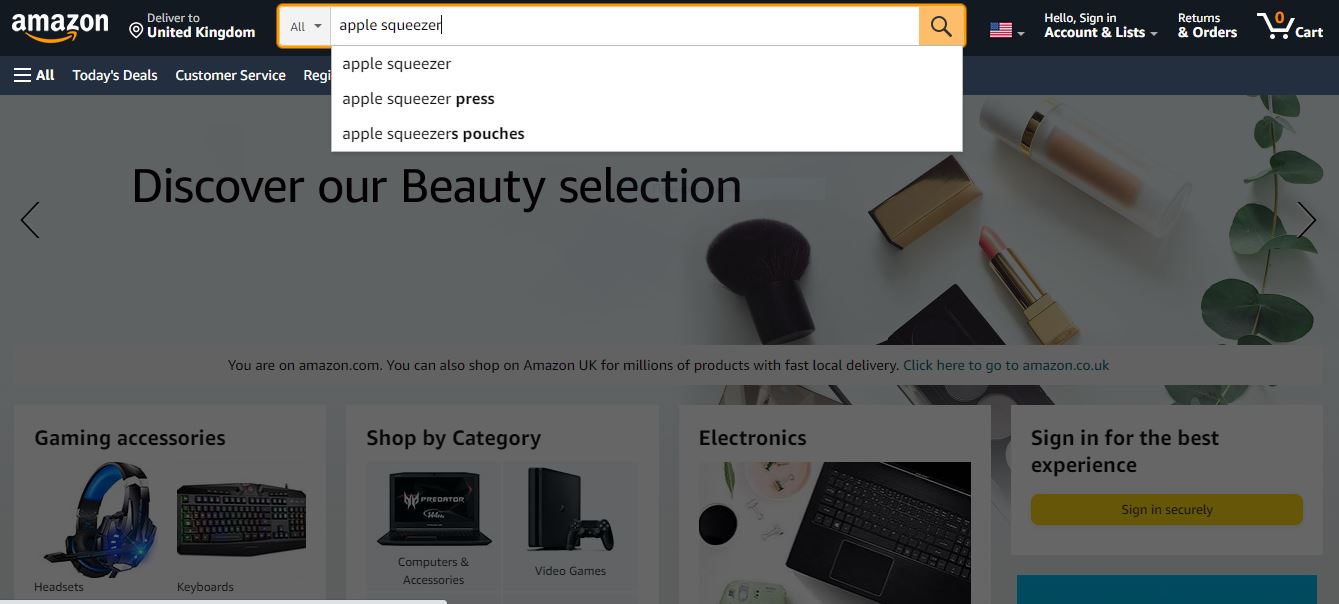Table of Contents
 Every seller who wants to make money on Amazon needs to ensure that their product reaches the right customer. Needless to say, if your item is an exact match to what a shopper looks for, that’s bingo.
Every seller who wants to make money on Amazon needs to ensure that their product reaches the right customer. Needless to say, if your item is an exact match to what a shopper looks for, that’s bingo.
Whenever a buyer wants to find a product, they search. More than 6 in 10 e-commerce shoppers start their product searches on Amazon.
Most often, they search for the product by entering search terms in the search bar. To match your product with the customer’s query, you’ll need to include keywords on your product listing. The higher the relevancy, the better your product will rank in the search results. This, in turn, increases sales and conversions. By the way, for sellers aiming to optimize their Amazon listings, tracking product listings is crucial. It involves monitoring changes in your listings and competitors, such as price adjustments, keyword ranking changes, and stock levels. SellerSonar provides alerts on these changes, helping sellers react promptly to maintain competitiveness and visibility on Amazon.
So, to find out which keywords work best for your product, you need to perform Amazon keyword research.
Read further to discover what are the different types of Amazon keywords, how to choose keywords for Amazon, and the methods to conduct keyword research with and without using the Amazon keyword tool.
What Is Amazon Keyword Research?
Keyword research on Amazon is the process when a seller finds and analyzes the search terms that their customers use. It helps choose the most efficient terms.
These search terms that shoppers enter into search engines, FBA sellers oftentimes use for search engine optimization (SEO).
Why is Amazon keyword research important for sellers?
When choosing the set of Amazon search keywords, you only need to select the ones that are most relevant to your product. These search terms should appear on your product title, frontend description, and listing backend.
Since the keywords are directing shoppers to your listing, you cannot add just anything as a keyword. Your keyword selection should be optimized for several reasons.
Firstly, irrelevant keywords create a terrible user experience. You should select your keywords having real buyer personas in mind. Imagine that a shopper looking for sunglasses finds wine glasses you sell. They’ll not buy your product.
Secondly, you shouldn’t use too many keywords on your listing. If you do so, it will not be readable. In addition, you won’t be able to present the right information about the product to your potential customers. Doing so is important to avoid returns and negative reviews. These unwanted effects may arise due to unclear item descriptions.
Thirdly, the quantity of characters you can use on the listing frontend and backend is limited. You should, therefore, be selective and use highly-performing search terms.
What Are Keywords?
So, what are keywords on Amazon? Keywords are specific words or phrases that are strategically included in the product title, bullet points, description, and backend search terms on Amazon.
These keywords are relevant to the product and reflect what potential customers may search for when looking for similar products on AMZ.
Effective keyword research on Amazon and utilization are essential for optimizing product visibility, improving search rankings, and attracting the right target audience to the listing.
How do keywords work on Amazon?
As soon as a shopper wants to find a product, they type the search query into the Amazon search bar. After that, they can see search results that Amazon ranks in a certain order.
To rank the search results, Amazon applies its proprietary A10 search algorithm. It escalates the best-performing inventory optimized by the most relevant Amazon search terms to the first Search Engine Results Page (SERP).
The relevant keywords help make your ASINs visible to the shoppers. They guide Amazon’s A10 algorithm right to your listing. The A10 algorithm ranks the product listings in the order of relevance to the shopper’s search query. It processes listings according to Amazon’s ranking criteria.
Importantly, the higher the product ranking, the better are sales volumes and conversion rates. Research shows that products on the first page of search results get at least 80% of all the clicks, while the first 3 listings on page 1 get at least 60% of those clicks, Additionally, only 30% of shoppers go beyond page 1 of the search results.

How Do I Conduct Amazon Keyword Research?
There are two types of approaches to keyword research. You can do it manually or automatically. To perform an automatic search, you can use the Amazon keyword tool.
First of all, you can easily determine the correct Amazon keyword tips for your products. Secondly, the keyword generator helps you ongoingly analyze your items’ listings and track keyword rankings. Thirdly, you can get keyword performance insights. Based on this information, you can optimize your SEO and marketing strategies by the book.
Meanwhile, you can use manual keyword research methods as an additional keyword source.
Manual keyword research
The most effective manual methods to find Amazon keywords are as follows.
#1. Automatic Amazon PPC Campaigns
When you run Amazon PPC campaigns in your Seller Central, you can choose between Manual Campaigns (you select the keywords yourself) and Automatic Campaigns (Amazon handles them automatically). In an automatic mode, you can extract a keyword report under Reports > Advertising. This way, you’ll get your top-converting keywords.
#2. Reverse ASIN Lookup
Reverse ASIN Search is the method that allows you to discover the most efficient competitors’ keywords. If you are enrolled in a Brand Registry, you can apply Amazon Brand Analytics as a reverse ASIN lookup tool.
#3. Amazon Autocomplete
Amazon autocomplete reveals the most frequently searched terms. Start typing a search query for your product in Amazon’s search bar. After that, you’ll see the typical search term sequences. Analyze them and filter out those that are the most relevant to your product.
#4. “Frequently Bought Together”
Look into the popular items that complement your product. By targeting complements, you can extract new keywords to reach new audiences.
#5. Google Ranking
There are sellers that have their own website, where they sell in addition to Amazon. In that case, they can utilize the Search Console to detect if it ranks for high-volume search queries. Such queries can be targeted as keywords on Amazon.
Tools for Amazon Keyword Research
Keyword research apps can help you detect all highly ranked Amazon search words relevant to your product. With that in mind, you can either build or improve your SEO strategy. In addition to keyword research, many of these services offer a range of additional features such as product research and listing optimization, making them valuable all-in-one solutions for Amazon sellers.
Amazon Keyword Rank Tracker by SellerSonar
SellerSonar monitoring software is an efficient way to stay on top of your sales. It offers instant Amazon alerts to protect your sales. Thus, you can stay aware of all listing changes, Buybox hijackers, new/deleted reviews, keyword rank history, and product suppressions. In addition to this, its keyword rank tracker can help you optimize your SEO strategy. Here’s how it works.
#1. Determine the relevant keyword set
After you have done your research and you have a list of the best Amazon keywords you want to track, you can use SellerSonar’s keywords tracker to get data-driven results.
Once you log in to your SellerSonar account, go to the Keywords page and click the button in the upper right corner to add your keywords Then, choose a product and enter all the keywords you wish to track. That’s it! Keep in mind that the data upload will take up to a few minutes.
Also, there is an option to upload keywords to all products in bulk. For that, use the File Import button to open a pop-up window. Then, download the template, fill it with your keywords, and upload your file with a single click.
When your keywords are uploaded, you will get a dashboard with information on Amazon search volume. Moreover, by clicking on a certain keyword, you will get three user-friendly charts to monitor changes in any keywords’ rank history, whether it’s organic or paid traffic, and see your product’s position compared to your competitors
#2. Reveal competitors’ search terms
SellerSonar will help you uncover the best-performing competitors’ keywords for Amazon listings. It will also make you aware of their marketing practices.
If your competitor listings are added, you can track organic and paid positions. It helps to identify keywords that tend to rank at the top on the search results page and earn more clicks.
You can compare your keyword rankings with your competitor’s rankings and analyze which keywords your competitors use to rank higher in search results and lead with a superior organic reach.
#3. Monitor your metrics history
With our tool, you’re able to monitor your product’s historical data. In the Summary section, you can quickly check your keywords’ performance as well as sponsored and organic ranks within the last 10 days, 30 days, 6 months, or last year. Look through overall statistics or filter the data by brand or product.
Furthermore, in the Competitors section, can compare product metrics with your competitors’ changes in price, BSR, product review numbers, keyword rankings, etc. Our competitor research tool provides convenient graphs to understand the product’s competitive landscape. For example, you can monitor your competitors’ BSR to respond to spikes and drops in sales and quickly adjust your sales strategy.
 This is just a taste of what SellerSonar has to offer. To explore the features firsthand, feel free to check out our demo or schedule a live meeting with our expert.
This is just a taste of what SellerSonar has to offer. To explore the features firsthand, feel free to check out our demo or schedule a live meeting with our expert.
Optimizing Product Listings with Keywords
Optimizing product listings with keywords is essential for improving visibility and driving sales on Amazon. Here’s how to do it effectively:
- Strategic Placement: Incorporate your primary keywords naturally into your product title, bullet points, description, and backend search terms. Focus on readability and relevance to ensure that your listing resonates with both customers and Amazon’s search algorithm.
- Prioritize Relevance: Choose Amazon key words that accurately describe your product and match what shoppers are likely to search for. Avoid keyword stuffing or using irrelevant terms, as this can harm your listing’s performance and credibility.
- Long-Tail Keywords: Don’t just focus on broad, high-volume keywords. Include long-tail keywords, which are longer and more specific phrases that capture the intent of potential buyers. These keywords often have less competition and higher conversion rates.
- Optimize Images and Backend Keywords: Don’t overlook the importance of images and backend keywords. Use high-quality images that showcase your product and include relevant keywords in the backend search terms section to further improve your listing’s visibility.
- Monitor Performance: Regularly monitor the performance of your keywords using SellerSonar’s keyword rank tracker. Continuously refine your strategy based on new data and insights to maintain a competitive edge.
Try SellerSonar now. Register for our 29-day trial and boost your incredible journey of running your business on the online platform.





